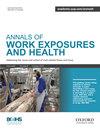200 Adapting the BOHS COVID-19 risk matrix to Avian Influenza. Preparing an animal charity for future outbreaks
IF 1.8
4区 医学
Q3 PUBLIC, ENVIRONMENTAL & OCCUPATIONAL HEALTH
引用次数: 0
Abstract
Based on a similar exercise carried out by the BOHS in 2020 during the early stages of the COVID-19 pandemic. The BOHS COVID-19 risk matrix was adapted to provide an animal charity with an Avian Influenza (AI) risk management tool. The charity staff handle sick and dead birds in the wild (symptoms of AI may not be immediately apparent) and at their animal treatment and housing centres. This tool guides the employer in determining appropriate control measures to help reduce the risk of their staff, and also the public, from being infected with AI. Although there is currently limited evidence of transference to humans and the risk appears to be low, this could change in the not too distant future. Cross species infections are predicted to increase with the habitat pressures brought about by climate change. Therefore this AI risk matrix has been developed as a precautionary approach. The approach recognises the pitfalls of reliance on PPE alone and endeavours to promote a preventative approach built on good occupational hygiene practice. Given the variety and complexity of the workplace, the AI risk matrix provides an initial reference for control measures, risk evaluation, and grouped job roles to help the employer make balanced decisions and decide what are the reasonable precautions. Acknowledgements- Authors of the BOHS COVID-19 risk matrix Kelvin Williams BSc(Hons) DipOH CFFOH Dr Mangala Patil-Mead200 根据禽流感调整 BOHS COVID-19 风险矩阵。让动物慈善机构做好应对未来疫情的准备
基于 2020 年 COVID-19 大流行初期由英国皇家动物卫生协会开展的类似演习。英国皇家动物卫生局对 COVID-19 风险矩阵进行了调整,以便为一家动物慈善机构提供禽流感(AI)风险管理工具。该慈善机构的工作人员在野外(禽流感症状可能不会立即显现)以及在其动物治疗和饲养中心处理病鸟和死鸟。该工具指导雇主确定适当的控制措施,以帮助降低员工和公众感染禽流感的风险。虽然目前向人类传播的证据有限,风险似乎也很低,但在不远的将来,这种情况可能会发生变化。据预测,随着气候变化带来的生境压力,跨物种感染将会增加。因此,本人工智能风险矩阵是作为一种预防方法制定的。该方法认识到仅依靠个人防护设备的缺陷,并努力推广建立在良好职业卫生实践基础上的预防方法。鉴于工作场所的多样性和复杂性,人工智能风险矩阵为控制措施、风险评估和工作角色分组提供了初步参考,以帮助雇主做出平衡的决定,并确定哪些是合理的预防措施。致谢- BOHS COVID-19 风险矩阵的作者 Kelvin Williams BSc(Hons) DipOH CFFOH Mangala Patil-Mead 博士
本文章由计算机程序翻译,如有差异,请以英文原文为准。
求助全文
约1分钟内获得全文
求助全文
来源期刊

Annals Of Work Exposures and Health
Medicine-Public Health, Environmental and Occupational Health
CiteScore
4.60
自引率
19.20%
发文量
79
期刊介绍:
About the Journal
Annals of Work Exposures and Health is dedicated to presenting advances in exposure science supporting the recognition, quantification, and control of exposures at work, and epidemiological studies on their effects on human health and well-being. A key question we apply to submission is, "Is this paper going to help readers better understand, quantify, and control conditions at work that adversely or positively affect health and well-being?"
We are interested in high quality scientific research addressing:
the quantification of work exposures, including chemical, biological, physical, biomechanical, and psychosocial, and the elements of work organization giving rise to such exposures;
the relationship between these exposures and the acute and chronic health consequences for those exposed and their families and communities;
populations at special risk of work-related exposures including women, under-represented minorities, immigrants, and other vulnerable groups such as temporary, contingent and informal sector workers;
the effectiveness of interventions addressing exposure and risk including production technologies, work process engineering, and personal protective systems;
policies and management approaches to reduce risk and improve health and well-being among workers, their families or communities;
methodologies and mechanisms that underlie the quantification and/or control of exposure and risk.
There is heavy pressure on space in the journal, and the above interests mean that we do not usually publish papers that simply report local conditions without generalizable results. We are also unlikely to publish reports on human health and well-being without information on the work exposure characteristics giving rise to the effects. We particularly welcome contributions from scientists based in, or addressing conditions in, developing economies that fall within the above scope.
 求助内容:
求助内容: 应助结果提醒方式:
应助结果提醒方式:


